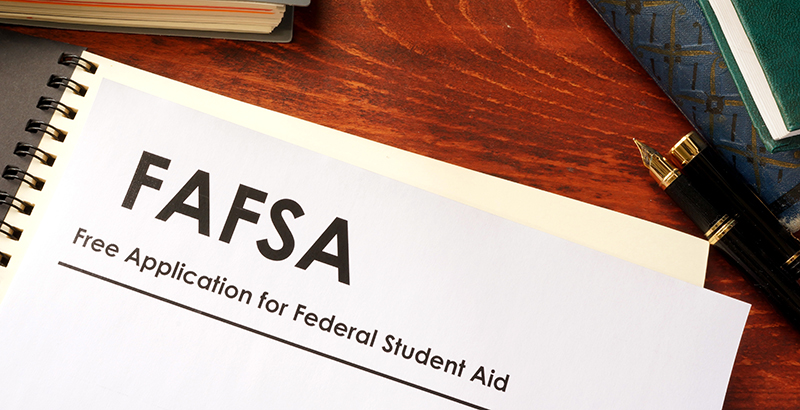Reyna: 6 Steps Toward Getting More High School Students to Complete the FAFSA and Launch Their College Careers

It’s no secret that in our 21st century economy, education or training beyond high school is critical to securing a good job with advancement potential. But earning a postsecondary degree, licensure or other credential is easier said than done. Policymakers must address significant challenges — not the least of which is college affordability — as they grapple with how to increase the number of high school graduates who enroll and succeed in postsecondary education.
One strategy may be simpler than you’d expect: prioritizing completion of the Free Application for Federal Student Aid (FAFSA). The FAFSA opens doors to postsecondary education by qualifying students for federal assistance and, increasingly, to other need- and merit-based aid from states, institutions and private funders. Research shows that simply completing the FAFSA significantly increases the likelihood that a student will both enroll and persist in college.
Yet every year, hundreds of thousands of students — more than one-third of last year’s high school seniors — fail to complete the FAFSA. It’s estimated that up to half of them would have been eligible for a Pell Grant, federal aid reserved for low-income students. FAFSA completion rates are disproportionately lower among low-income students and students of color, contributing to the perpetuation of the degree attainment gap. Students who need the aid most are the least likely to complete the form; for every 10 percentage point increase in students from low-income families, districts nationwide see a 3 percent decrease in FAFSA completion. Each year, instead of fueling postsecondary ambitions, more than $3 billion in aid is left unclaimed on the table.
How can we dramatically increase our nationwide 62 percent FAFSA completion rate in the years to come? Several states have begun to develop and act on effective strategies, but more states and communities must step up their efforts. Here are six steps that leaders and practitioners can take right now to start moving the needle.
- Educate and empower. One of the most significant barriers to FAFSA completion is a lack of understanding among students and their families about what the FAFSA is, why it matters and how to complete it. Although Congress recently took major steps to simplify the form, it is still complex and overly burdensome. The Ohio Department of Higher Education is seeking a solution with the FAFSA Help Ohio website, which contains resources for guidance counselors, students and families. Other communities have empowered students and families to inform their networks about the importance of the FAFSA and offer assistance to complete the form.
- Start a friendly competition. Few things motivate like competition, and several states and districts have successfully raised their FAFSA completion rates by setting up completion challenges with their neighbors. In 2018, spurred by a Twitter challenge, Tennessee and Louisiana set out to see which state could get the highest percentage of high school graduates to complete the FAFSA. Louisiana narrowly edged out Tennessee, but both states ended up with completion rates above 80 percent — the highest in the country. At the district level, Chiefs for Change recently implemented a FAFSA Fast Break competition for its members, complete with a real-time leader board displaying the districts with the highest completion rates. Whether it’s states, districts or individual schools challenging one another, ultimately, everyone wins.
- Consider statewide FAFSA legislation. Tying FAFSA completion to high school graduation gives students a strong incentive to fill out the form. Though states can and should provide a means for those who wish to opt out, setting completion as the default expectation for graduation can bring about a dramatic spike in participation. After Louisiana made FAFSA completion a high school graduation requirement, its completion rate rose by 26 percentage points. Texas and Illinois created this requirement in 2019, and a number of states, including Indiana and Hawaii, are considering legislation this year.
- Build shared ownership. States should convene leaders from across K-12 and higher education to build shared ownership over reaching a higher FAFSA goal. The Tennessee Higher Education Commission manages a team with representatives from the state Department of Education, tnAchieves (Tennessee College Scholarship and Mentorship), the Tennessee Student Assistance Corp. and the Ayers Foundation to design and implement a FAFSA completion plan each year. Across the country, there are hundreds of college access organizations that states and communities can bring together to align efforts and reach more students.
- Use data to measure progress. There can’t be progress without good data. States can and should lead the way in ensuring that high school counselors and principals have access to the student-level data they need to provide individualized support. Colorado’s higher education agency worked with districts to establish data-sharing agreements so that it could develop a tool that provides real-time information about which students have completed the FAFSA. The tool was built for open access and shared with other states to adapt to their needs.
- Build and leverage capacity. Moving the needle on FAFSA completion requires boots on the ground to help students across the finish line. High school counselors are often overwhelmed, so it’s up to states to expand the pool of prepared adults who can offer direct assistance to students and families. For example, the Texas Higher Education Coordinating Board established college and career information centers within institutions of higher education to provide advising services to high school students. Staffed by current college students, these centers partner with local high schools to host FAFSA nights and work individually with students. Other states and communities have employed retirees as help desk staff to answer families’ questions, partnered with tax preparation firms and sent volunteers into communities to provide face-to-face support.
Completing the FAFSA is a clear, attainable step that students can take to improve their chances of enrolling and succeeding in postsecondary education. Record high school graduation rates in recent years have proved that targeted state efforts can move the country forward. Now is the time to set a new national record for FAFSA completion; it’s within our grasp, and we owe it to students to prioritize opening this door to opportunity.
Ryan Reyna is senior director of Education Strategy Group.
Get stories like these delivered straight to your inbox. Sign up for The 74 Newsletter

;)
